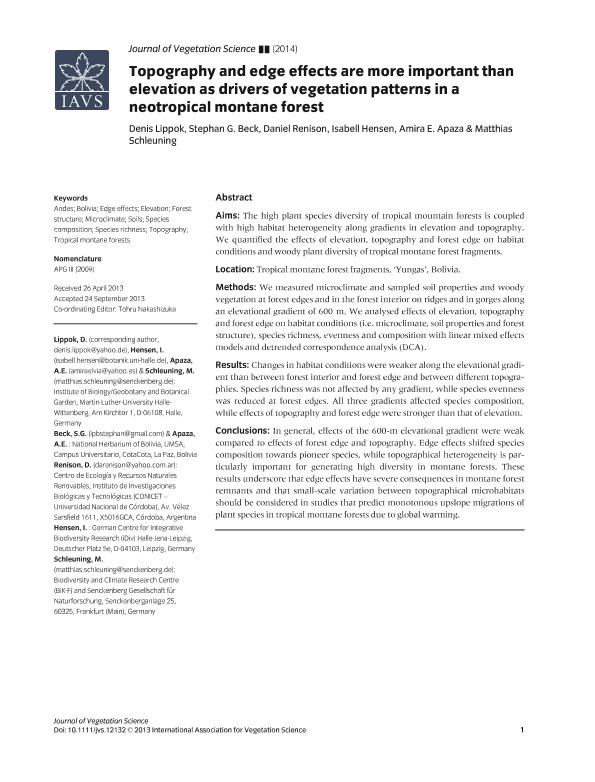Artículo
Topography and edge effects are more important than elevation as drivers of vegetation patterns in a neotropical montane forest
Lippok, Denis; Beck, Stephan G.; Renison, Daniel ; Hensen, Isabell; Apaza, Amira E.; Schleuning, Matthias
; Hensen, Isabell; Apaza, Amira E.; Schleuning, Matthias
 ; Hensen, Isabell; Apaza, Amira E.; Schleuning, Matthias
; Hensen, Isabell; Apaza, Amira E.; Schleuning, Matthias
Fecha de publicación:
12/2013
Editorial:
Wiley
Revista:
Journal of Vegetation Science
ISSN:
1100-9233
Idioma:
Inglés
Tipo de recurso:
Artículo publicado
Clasificación temática:
Resumen
Aims: The high plant species diversity of tropical mountain forests is coupled with high habitat heterogeneity along gradients in elevation and topography. We quantified the effects of elevation, topography and forest edge on habitat conditions and woody plant diversity of tropical montane forest fragments. Location: Tropical montane forest fragments, ‘Yungas’, Bolivia. Methods: We measured microclimate and sampled soil properties and woody vegetation at forest edges and in the forest interior on ridges and in gorges along an elevational gradient of 600 m. We analysed effects of elevation, topography and forest edge on habitat conditions (i.e. microclimate, soil properties and forest structure), species richness, evenness and composition with linear mixed effects models and detrended correspondence analysis (DCA). Results: Changes in habitat conditions were weaker along the elevational gradient than between forest interior and forest edge and between different topographies. Species richness was not affected by any gradient, while species evenness was reduced at forest edges. All three gradients affected species composition, while effects of topography and forest edge were stronger than that of elevation. Conclusions: In general, effects of the 600-m elevational gradient were weak compared to effects of forest edge and topography. Edge effects shifted species composition towards pioneer species, while topographical heterogeneity is particularly important for generating high diversity in montane forests. These results underscore that edge effects have severe consequences in montane forest remnants and that small-scale variation between topographical microhabitats should be considered in studies that predict monotonous upslope migrations of plant species in tropical montane forests due to global warming.
Palabras clave:
Andes
,
Bolivia
,
Edge Effects
,
Elevation
Archivos asociados
Licencia
Identificadores
Colecciones
Articulos(IIBYT)
Articulos de INSTITUTO DE INVESTIGACIONES BIOLOGICAS Y TECNOLOGICAS
Articulos de INSTITUTO DE INVESTIGACIONES BIOLOGICAS Y TECNOLOGICAS
Citación
Schleuning, Matthias; Apaza, Amira E.; Hensen, Isabell; Renison, Daniel; Beck, Stephan G.; Lippok, Denis; et al.; Topography and edge effects are more important than elevation as drivers of vegetation patterns in a neotropical montane forest; Wiley; Journal of Vegetation Science; 25; 3; 12-2013; 724-733
Compartir
Altmétricas



